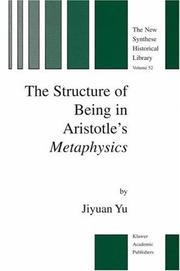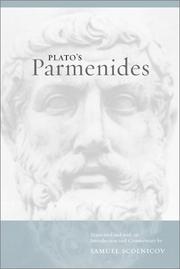| Listing 1 - 2 of 2 |
Sort by
|

ISBN: 1402015372 9401039917 9401000557 Year: 2003 Volume: 52
Abstract | Keywords | Export | Availability | Bookmark
 Loading...
Loading...Choose an application
- Reference Manager
- EndNote
- RefWorks (Direct export to RefWorks)
In his Metaphysics, Aristotle claims that he is seeking to establish a science of being. Being, at the most general level, is divided by Aristotle into the following four types: 1. Accidental being 2. Being as truth 3. Potential/actual being l 4. Per se being Per se (kath hauto) being can also be translated as "being in its own right" or "intrinsic being". This type of being has been referred to by Aristotle in different ways. The list of per se beings includes substance, quantity, quality, place, time, etc. , and this is also the list ofcategories. At Meta. ix. l, 1045b28 Aristotle calls this list the "categories of being" (hai kategoriai tou ontos). At Meta. vi. 2, 1026a36 and ix. 1O, 1051a33-b2 per se being is called "being with reference to the figures ofpredication" (ta schemata tes kategorias, or "figures ofcategories,,). 2 Of these four types of being, accidental being is briefly treated in Meta. vi. 2-3 and there Aristotle claims that the study of accidental being can be dismissed on the grounds that accidental being is indeterminate and cannot be 3 the object ofknowledge. He also does not pay much attention to being as truth and treats it briefly in two short texts: Meta. viA and ix. 1O.
Being --- Etre (Philosophie) --- Ontologie --- Ontology --- Zijn (Filosofie) --- Zijnsleer --- Ontology. --- Aristotle. --- Philosophy --- Metaphysics --- Necessity (Philosophy) --- Substance (Philosophy) --- Aristoteles. --- Aristotle --- Philosophy. --- Philosophy, Ancient. --- Metaphysics. --- Philosophy, general. --- Classical Philosophy. --- History of Philosophy. --- God --- Philosophy of mind --- Ancient philosophy --- Greek philosophy --- Philosophy, Greek --- Philosophy, Roman --- Roman philosophy --- Mental philosophy --- Humanities

ISBN: 1282355082 9786612355080 0520925114 1597348104 9780520925113 1417525517 9781417525515 9781597348102 0520224035 9780520224032 0520224035 9780520224032 9781282355088 6612355085 Year: 2003 Publisher: Berkeley : University of California Press,
Abstract | Keywords | Export | Availability | Bookmark
 Loading...
Loading...Choose an application
- Reference Manager
- EndNote
- RefWorks (Direct export to RefWorks)
Of all Plato's dialogues, the Parmenides is notoriously the most difficult to interpret. Scholars of all periods have disagreed about its aims and subject matter. The interpretations have ranged from reading the dialogue as an introduction to the whole of Platonic metaphysics to seeing it as a collection of sophisticated tricks, or even as an elaborate joke. This work presents an illuminating new translation of the dialogue together with an extensive introduction and running commentary, giving a unified explanation of the Parmenides and integrating it firmly within the context of Plato's metaphysics and methodology. Scolnicov shows that in the Parmenides Plato addresses the most serious challenge to his own philosophy: the monism of Parmenides and the Eleatics. In addition to providing a serious rebuttal to Parmenides, Plato here re-formulates his own theory of forms and participation, arguments that are central to the whole of Platonic thought, and provides these concepts with a rigorous logical and philosophical foundation. In Scolnicov's analysis, the Parmenides emerges as an extension of ideas from Plato's middle dialogues and as an opening to the later dialogues. Scolnicov's analysis is crisp and lucid, offering a persuasive approach to a complicated dialogue. This translation follows the Greek closely, and the commentary affords the Greekless reader a clear understanding of how Scolnicov's interpretation emerges from the text. This volume will provide a valuable introduction and framework for understanding a dialogue that continues to generate lively discussion today.
Dialectic --- Reasoning --- Ontology --- Polarity --- Polarity (Philosophy) --- Argumentation --- Ratiocination --- Reason --- Thought and thinking --- Judgment (Logic) --- Logic --- Plato. --- Zeno, --- Parmenides. --- Socrates. --- Socrates --- Socrate --- Zenón, --- Zénon, --- Zenon, --- Ζήνων, --- Zēnōn, --- Sokrates --- Sokrat, --- Sokrates, --- Suqrāṭ, --- Su-ko-la-ti, --- Sugeladi, --- Sokuratesu, --- Sākreṭīsa, --- Socrate, --- سقراط, --- Σωκράτης, --- ancient classics. --- ancient greece. --- ancient greek philosophy. --- classic philosophy. --- classical philosophy. --- classical thought. --- classics. --- eleatics. --- forms. --- greece. --- greek philosophy. --- greek translation. --- greeks. --- logic. --- metaphysics. --- monism. --- mystic. --- neoplatonism. --- parmenides. --- philosophy. --- plato. --- platonic metaphysics. --- platonism. --- religion. --- spirituality. --- western canon.
| Listing 1 - 2 of 2 |
Sort by
|

 Search
Search Feedback
Feedback About UniCat
About UniCat  Help
Help News
News